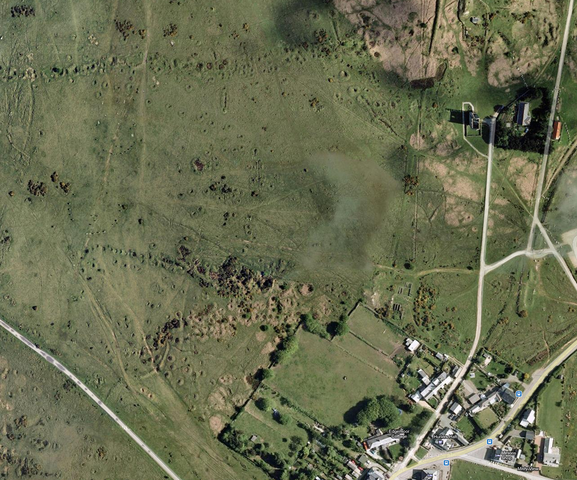SIMILAR IMAGES
IMAGE INFORMATION
EditPossibly one of the most well known ancient monuments in Cornwall, the Hurlers, near Minions (north of Liskeard) is an enigmatic complex, first mentioned by historian John Norden, who visited them around 1584. Situated on the moor NW of the village, there are three stone circles next to each other, two standing stones (the Pipers) nearby, and countless barrows and cairns including the famous Rillaton Barrow where the gold cup was found. Another stone circle lies a mile away on Craddock Moor to the northwest, and the Cheesewring natural formation is a similar distance away to the north. In addition, the area is littered with earthworks from the remains of post-medieval mining in the area.
Dating from the Bronze Age, the three circles lie close to each other and are roughly aligned in a NNE direction. Like many other circles, these stones have the reputation of being uncountable. The northerly circle has 15 stones remaining from a likely 24 original, four of these are now fallen. The circle, approximately 38 yards in diameter is the most circular of the three rings. The middle ring is less true and has a diameter varying between 46 and 49 yards. Just over half of the original 29 stones remain standing in this circle. The southern circle is the smallest, and most incomplete with only 9 of its original stones remaining in a circle of 34 yards diameter. A short distance west of this circle are the Pipers, a pair of 6-7 feet tall standing stones.
Unusually, the granite stones of the central circle show signs of having been smoothed by hammering, the quartz crystals from the work having been spread over the interior of the central circle. The inner faces of the stones are smooth and regular and most of the stones are flat topped and graded so that the tallest stones are to the south, which may support the idea of a processional route through the circles leading towards the north.
Of course, the fact that there are three rings, in a slightly out of alignment line, immediately draws comparison with the main stars of Orion’s Belt. In fact, many alignments have been postulated from the site, it is a particular feature of the monuments in this area that they tend to ‘refer to’ significant tors and horizon features, especially the tor enclosure on Stowes Hill and the group of large barrows on Caradon Hill. Astronomical alignments have also been noted.
The origin of the name has a story behind it, as you’d expect by now in common with many other Cornish circles.
Many centuries ago the game of hurling was popular in Cornwall, as it still is today. The villagers around St. Cleer loved the game and would play whenever they could, even on Sundays. Despite the disapproving lectures of the local saint and priest, St. Cleer himself, they continued to play for the honour of their village and a game was set for a Sunday against the villagers of St. Ives. St. Cleer went in search of his flock and found them in the midst of a hotly contested match. He ordered them to cease their game and respect the Sabbath but they told him to return to his prayers. Angered, he raised his staff and pronounced in solemn tones that since they preferred their game to the worship of God they must stay there forever more as a lesson to others. He lowered his staff and the players were instantly turned to stone, doomed to hurl forever on the wastes of Craddock Moor.
More briefly, in 1610, the historian William Camden wrote:
The neighbouring inhabitants terme them Hurlers, as being by devout and godly error perswaded that they had been men sometime transformed into stones, for profaning the Lord’s Day with hurling the ball.
Of course, this story is a nonsense. St. Cleer lived sometime between 700 and 900 CE. He preached and built a church on the edge of Bodmin moor – today’s village is named after him, and contains a Holy Well and ancient crosses. The stones of course, predate the saint by two to three thousand years.
Information provided from - http://megalithicmumbles.wordpress.com/

